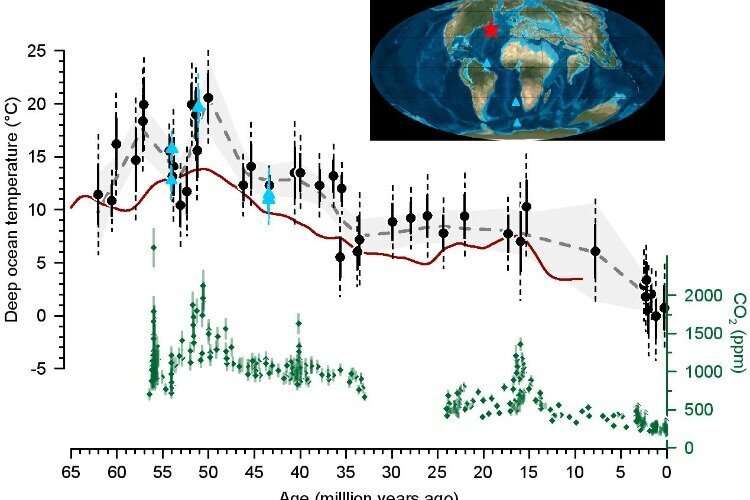History of deep ocean temperature and atmospheric CO2 change. Previous temperature estimates are shown with a red line, with new data in symbols. Credit: University of St Andrews
A new study of ancient ocean temperatures, published today in Scienceshows that the deep North Atlantic was once 20 °C (68 °F) – warmer than the surface of the modern Mediterranean.
Scientists say the new data, spanning the past 60 million years, pinpoint the massive impact of higher CO. demonstrate2 levels in the geologic past, emphasizing the urgent need for sustained CO. to avoid2 increase in the future.
“Today, the deep ocean is filled with icy water,” said Dr. James Rae of the University of St Andrews, who co-authored the study, “but 50 million years ago it was as warm as the Mediterranean is today.”
The international team, made up of scientists from Norway, the Netherlands, Switzerland and the US, used the chemical fingerprints of small fossil shells from deep-sea mud cores to reconstruct ancient ocean temperatures. Using state-of-the-art new lab measurements, they were able to obtain the most accurate temperature estimates to date, showing that temperatures were warmer — and more variable — than previously thought.
Professor Nele Meckler, from the University of Bergen, who led the study, explained: “We looked at the way different carbon and oxygen atoms clump together in these ancient shells, which has proven to be a very accurate method of measuring the temperature on the surface. moment the shells were formed.”
Groups of atoms in sand-sized microfossil shells like this one reveal a warm ancient ocean. Credit: University of St Andrews
dr. Phil Sexton, a co-author of the Open University study, added: “Because mud and shells are constantly piling up on the seafloor, a long tube of this mud – up to 2 miles long – is like a time capsule. The deeper you go. goes into the core, the older the fossil shells, and by measuring the shell chemistry, we get a long record of past climate change.”
The 20°C temperatures for the deep North Atlantic come from a time called the Eocene, about 15 million years after the end of the dinosaurs, when atmospheric CO2 was about three times higher than today. Previous fossil indicators have shown that this time was characterized by super-warm temperatures, with palm trees and crocodiles populating the Arctic, and the new study shows that this extreme heat was also felt in the ocean depths.
dr. Rae said: “These old greenhouse climates may seem a long way from today, but they are critical to helping us understand the impact of CO.2 about climate change.”
He added: “While these super-hot greenhouse climates happened a long time ago, they are critical to helping us understand the impact of CO.2 about climate change in the future.
“CO2 has transformed the face of our planet before, and unless we cut emissions ASAP, it will do it again.”
Bali-Like Temperatures in Wyoming? Fossils Reveal Tropically Hot North America 95 Million Years Ago
AN Meckler et al, Cenozoic evolution of deep ocean temperature from clotted isotope thermometry, Science (2022). DOI: 10.1126/science.abk0604
Quote: Depths of the North Atlantic Ocean once as warm as the Mediterranean (2022, July 6), retrieved July 6, 2022 from https://phys.org/news/2022-07-depths-north-atlantic-ocean- mediterranean.html
This document is copyrighted. Other than fair dealing for personal study or research, nothing may be reproduced without written permission. The content is provided for informational purposes only.

